Riga 700th Anniversary Celebration June-August 1901.
Aģentūra Rīga 800.
the Collections of the Latvian Academic Library
Riga 700th Anniversary Celebration June-August 1901. |
This
Digital Exhibition was financed and it's style was
designed by the Aģentūra Rīga 800. |
|
| Pictures, Printed Material and
Manuscripts from the Collections of the Latvian Academic Library |
The Department of Manuscripts and Rare Books and the Misiņš Library of the Latvian Academic Library have centuries old documents that tell about events in Riga social life, including festive events and anniversary festivities. There are rare and expressive documents that are rich in information and tell about Riga 700th anniversary in 1901.
On 12 May 1899, 150 manufacturers and craftsmen came together in the hall of the Crafts Society and decided to arrange an exhibition of industry and crafts dedicated to Riga 700th anniversary in the Esplanade in the summer of 1901, in support of the idea of engineer F.Wyganowski.
The Managing Committee was headed by C.Lovis and consisted of 12 members, among them: engineers B.Schubert and G.Kerkovius, honorary chairman G. Armitstead - Mayor of Riga.
Competition of construction plans for Riga Anniversary Exhibition was completed in February 1900. Nine plans were handed in; the plan by M. Scherwinsky - architect and director of Riga School for Crafts - won the prize, its motto was “1901”.
 |
Max Scherwinsky (1859-1909), director of Riga School for Crafts, architect. |
The exhibition was planned and made ready in a short time; it was opened on 1 June 1901. On 21 June Riga City Theatre gave a festive concert and a show - A. Freytags-Loringhoven’s historical poem about Riga that was illustrated by live pictures - History goddess and Daugava mermaids accompanied A. Knopken, M. Giese, Gustavus II Adolphus, also J.G.Herder and J. F. Hartknoch who entered the stage. On 21 June an organ music concert and service dedicated to Bishop Albert were held in the Dome Cathedral.
G.Armitstead in his appeal “Fellow-citizens” of 11 June expressed his and the City Council’s hope that all the social circles would do their best for the anniversary to turn out praiseworthy. The culmination of the anniversary activities was on 22 June 1901. “Countless flags were streaming on the roofs of houses. City houses, also private ones, were adorned with flower garlands, balconies as well as shop-windows were also decorated. In Kaļķu iela flower garlands were erected across the street like a triumphal arch with a drawing in them, with the oldest Riga coat-of-arms on one side and the picture of Bishop Albert on the other. Another triumphal arch was in the middle of the Pontoon bridge with the inscription ‘Long live Riga!’ in it.”
Festivities were introduced by morning services , music from Old Riga towers was played in the afternoon, and later water festivity took place in the Daugava, and there were trips with steam-boats “Kondor” and “Mitava” that were hired by the City Council. “Numerous people gathered on the Daugava bank and the Pontoon bridge. Small ships and boats were swarming in the Daugava in such numbers as never before, they were splendidly decorated and lit. Riga Latvian Society [ bill for the trip] had arranged real Latvian Midsummer Night bonfires and burning tar barrels.”
 |
| Panorama of Riga with ships in the Daugava. Photograph by E.Eggert. |
Everybody admired the barge adorned by the Riga Latvian Society; the festive barge was arranged and navigated by Augusts Dombrovskis. It consisted of 6 rafts tied together and it was 210 feet (i.e. about 70 m) long and 80 feet (i.e. 27 m) wide, it was tugged by the steam-boat “Parat”. The barge was so richly adorned with birch-boughs that it looked like a floating island, there was a platform, a terrace and a dance floor, and 2000 people, guests and a choir, could take seats on it. During the final stage of the unusually magnificent fireworks a colourful Riga coat-of-arms was unexpectedly highlighted. The brightly lit houses on the bank were an addition to the magnificent sight. Electric bulbs formed golden figures “700” in the sky above the Podrags cement mill. Iron and Pontoon bridges were also brightly glittering and like fiery lines were reflected in the dark waters of the Daugava.
On 23 June, according to G.Armitstead’s order, a feast was arranged in the city alms-houses, and army orchestra played on the Jēkabs Square, on the square of the Koju Island, near St Paul’s church and Āgenskalns market in the afternoon (from 4 to 8 p.m.). There were dance floors and other amusements.
On 23 June at 8 p.m. the Mayor G.Armitstead organized a garden party for 2000 guests in the Strēlnieku (Riflemen’s) Garden. “Gentlemen were wearing tailcoats and all ladies were wearing evening dresses. Tea was served first, then punch and beer and later the guests were invited to sumptuous meal. “Refreshments were served in small tents; long tables with snacks were in the big veranda and Stritzky’s pavilion.” The Naval Military School Orchestra played “Baltic March” by Hlawacz. “When it became dark and the Garden and Strēlnieku Association House were glittering in colourful lights, and splendidly dressed people were walking among greenery decorated with Chinese lanterns, it was a wonderful sight.”
Other activities followed: anniversary regatta with foreign yachts participating in the Daugava and the sea on 5 and 6 August, the fraternity “Fraternitas Rigensis” festivity in Torņakalns, bicyclists ride, competitions of shots and gymnasts.
In honour of Riga anniversary the first electric tram line - “electric railway” -was opened on 10 July on Lielā Aleksandra iela (tram-cars were produced in the Russian - Baltic carriage plant in Riga) and the decision was made to lay out an open park in Ķeizarmežs (Kaiserwald).
Riga Latvian Society decided to found Latvian Industrial and Crafts School.
Industrial and Handicrafts Exhibition
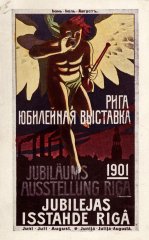 |
 |
| Poster "Anniversary Exhibition Riga 1901" (postcard) | Advertisement of the Anniversary Exhibition. |
Bottle stoppers, cigars, pianos, tram-cars, tombstones, an oak altar, bobbin-lace, preserves, porcelain, files, chains, tile stoves, steam-engines, orchids, perfume, beer, polygraphic equipment, furniture, motors, the first car in Russia...
Industrial and Handicrafts Exhibition is considered the most important event of Riga 700th anniversary. The Exhibition took place in Esplanade, and 775 participants took part in it, both from Riga (76.1%) and other Baltic cities and towns - both big industrial enterprises and private companies and craftsmen.
 |
| A view of the Anniversary Exhibition. Photograph by P.Sohnwald. |
A real Art Nouveau wooden building “town” consisting of a big and small Industry Halls ,Construction Hall, big and small Machinery Halls, Gardening Hall, several restaurants, fountains, open-air stage and other structures (altogether 21 edifices) and 26 private pavilions were built for the exhibition needs in the formerly vacant and sandy Esplanade square.
 |
 |
 |
| Restaurant. | Industry Hall. Fountain (postcard). | A.G.Ruhtenberg's pavilion (postcard). |
Rich and decorative mural paintings were made by masters from N. Lebedeff’s workshop. A splendid park was laid out under the guidance of Georg Kuphaldt. A special bridge, designed by engineer Wodsinski connected Esplanade and Strēlnieku Garden.
 Nr1 Nr1 |
 Nr2 Nr2 |
| N.Lebedeff's painting studio: prospectus. | |
The newspaper “Rigaer Tageblatt” wrote on 27 June, “The Exhibition confirms victory of the so-called new style – Art Nouveau – in everything. Only few craftsmen ignore it. It is very exciting to observe the influence of the new style in shop-windows, especially the windows of the companies A.Lyra, H.Goegginger, J.V.Mündel, H.A.Brieger correspond to Vienna Art Nouveau”.
It should be added that some people wanted to sell their pavilions after the Exhibition. There were advertisements in newspapers that the outlandish B. Herrmann’s pavilion and “Livonia “ and “Ilgezeem” pavilion were offered for sale.
To delight the visitors, the exhibition square and buildings were brightly lit in the evenings by 1250 incandescent lamps, 175 arc lamps and 2 searchlights by the fountain, and a huge electric sun lit the whole exhibition from the dome of the main building. The press wrote enthusiastically about the brilliance of electric light and described the power station and accumulator room that had been arranged especially for the exhibition needs. The “Lighting Festivity” attracted numerous spectators and was organized on each Sunday, Monday and Thursday (in late August every day) from 10 to 11 in the evening.
 Nr1 Nr1 |
 Nr2 Nr2 |
| Catalogue of Mündel
& Co factory of cigars, tobacco and Russian
cigarettes. A view of the shop from Kungu iela (price-list) |
 Nr1 Nr1 |
 Nr2 Nr2 |
 Nr3 Nr3 |
Catalogue of A.G.Ruhtenberg's factory of cigars, tobacco and Russian cigarettes. The factory was situated on the corner of Antonijas and Dzirnavu iela. |
The exhibits were estimated in 16 groups and sub-groups: food industry, clothing and textile industry, leather, building and furnishings, ceramics, wood and haberdashery industry, metal industry, precision mechanics, mechanical and electrical engineering, chemical industry, paper industry and polygraphy, applied arts, craftsmanship and business education, gardening, literature; and 258 experts attributed awards to the exhibition participants.
The awards were: Managing Committee medals (75 gold, 150 silver, 105 bronze), national medals (10 gold, 20 silver, 40 bronze), awards, diplomas.
 |
Diploma (design by lithographer A.Standke, company "Ernst Plates") |
Prizes and recognition diplomas were awarded to 56 Latvian craftsmen, among them 7 gold medals: to carpenters M.Pagasts (2 gold medals) and D.Bikars, masons K.Ķergalvis and P.Radziņš, sculpture company “S.Otto and O.Wassil” and the company “Kurau and Passil” - for mural paintings for the Anniversary Exhibition.
The Anniversary awards were exhibited in A.Lyra’s shop window in Tirgoņu iela, later in the Representation room of the Industry Hall.
Some samples of comments made by some Exhibition visitors in press:
The newspaper “Dienas Lapa” admitted that the tile company owned by Zelm and Böhm “has proved that its goods were far ahead of any company in Russia”.
 |
Advertisement of the tile factory "Zelm & Böhm" |
As a particular rarity J.Braun’s oak altar in Gothic style was exhibited. It was already sold for 4 500 roubles to some Catholic church in Samara province. Carpenter S.Kirstein had made a big library bookcase “with 3 ladders, 2 chairs and a communicating door in it. He had worked on it for 18 years, it was exhibited in an industrial exhibition in 1883, and later it was supplemented with more details. Its price is 20 000 roubles.”
“H.A.Brieger’s series of perfumery goods in nice wrappings: “Flora Violetta”, “Mayflowers”, “Rose de la France” – consisting of soap, perfume, eau de cologne, powder, sachets were offered as presents.”
“J.Tresselt company’s Empire style grand pianos correspond to French taste, but we consider their floral ornaments too realistic.“
Different jobs were performed during the Exhibition. Newspapers reported that nicely dressed girls were busy making cigars and Russian cigarettes in the stand of Mündel & Co, and in such a way about 40 000 (!) cigars were made. Seamstresses were demonstrating possibilities of Singer’s sewing-machine, N. H. Mantel’s company’s cardboard machine was working and making white wood into cardboard.
“Gardening has proved that it is able to turn sand deserts into blooming flower gardens. We have known the Esplanade square to be a sandy open space where even weeds did not grow, but when the Exhibition was opened, magnificent sights surprised us. What the Exhibition would be without gardens? A cluster of bare buildings. Now plants grew, developed, bloomed, faded, and were changed in the squares of the Exhibition.”
Gardeners displayed both open-air and indoor plants: araucarias, draceanas, lilies, orchids, tuberoses, fruit-trees with fruit in pots and tubs, and vines with grapes. Laurels and flowering plants that were used to decorate the Exhibition Square were sold out later.
Both organizers and participants thought about advertisements of the Exhibition.
Artist R.Zariņš¸ had created an impressive poster “Anniversary Exhibition Riga 1901” that was printed in A.Grosset’s lithographic enterprise. The poster was distributed free of charge in the railway station and in the Exhibition. Its motif was used for a 4-coloured anniversary stamp, was inserted in the Exhibition advertisements and was also reproduced as a postcard.
 |
R.Zariņš. Poster "Anniversary Exhibition Riga 1901" (postcard) |
Free Exhibition guidebooks with Riga and Exhibition plans were published by J.A Freijs and A.Grothuss. “Illustrated Riga Guide” published by E.Plates cost 30 copecks. Exhibition catalogues could be obtained at the entrance booking office and in the press office in the Esplanade.
A number of brochures, catalogues and advertisements of industrial enterprises, shops and restaurants were published, they were illustrated with colour and black-and-white pictures.
 |
 Menu. Menu. |
| Riga anniversary party of the German Society of Saint Petersburg on 8 May: menu. |
Riga anniversary and the Anniversary Exhibition inspired craftsmen - producers of souvenirs and keepsakes, e.g. jeweller G.H.Schmidt offered anniversary badges for 50 copecks (gilded ones for 65 copecks), publisher E. Plates a 4-coloured stamp with inscriptions in 3 languages. To please smokers “Mündel & Co” produced anniversary cigars “Albert” and “Riga 700”, L.Vissor - cigars “Anniversary”, but A.G.Ruhtenberg - Russian cigarettes “Anniversary” and “Exhibition”, A.S.Maikapar - Russian cigarettes “Riga”. T. Riegert offered “Anniversary” chocolate and caramels. Cloth and paper napkins and letter-paper with sights of Riga and shopkeepers’ advertisements as well as anniversary cravat were sold.
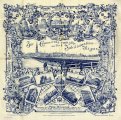 |
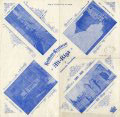 |
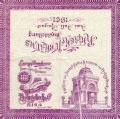 |
| Cloth napkin. C.Schulz's lithographic enterprise. | Paper napkin form the Town Hall restaurant in "Old Riga". | Anniversary Exhibition, Th.Angelbeck's coffee pavilion: paper napkin. |
Unrivalled was J. Redlich’s English Shop that offered numerous keepsakes: paper-knives like figurines of Bishop Albert, Walter von Plettenberg or Roland, mocha spoons, pewter mugs, pocket-knives with coat-of-arms and sights of Riga. Even a bottle-stopper in the form of Roland could be bought at J.Redlich’s. Lacquer ash-trays and candy-boxes displayed Riga sights on them.
Valuable keepsakes were Anniversary medals with sights of Riga and the Industry Hall. Bruno Kruse in Berlin, forged commemorative medal, ordered by Riga Council, in silver according to Anton Buchholtz’s idea (silver medal cost 12.5 marks, bronze - 7 marks).
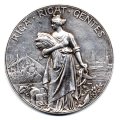 Nr1 Nr1 |
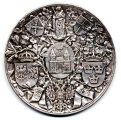 Nr2 Nr2 |
| Commemorative medal by B.Kruse (Berlin). | |
The medal praised Riga as a cultural, industrial, trade and agricultural centre, that was foreseen to have a happy future. “Riga rigat gentes” was the motto proposed by N. Busch. Stereotype blocks of the medals of the Anniversary Exhibition were offered on sale in the editorial office of the newspaper “Rigaer Tageblatt” and in Müller’s bookshop.
The Exhibition organizers presented S. Witte, Minister of Finance and the State Secretary - the honorary chairman of the Anniversary Exhibition - with a magnificent album.
M.Scherwinsky compiled a richly illustrated book “Die Rigaer Jubilaeums - Ausstellung 1901 in Bild and Wort: Ein Erinnerungsbuch” Riga, 1902, that provided information about the organizers of the Exhibition, its finances, preparatory stage, winners of prizes, the pavilions and their arrangement.
Budget.
The Anniversary Exhibition budget was planned to be 214 000 roubles, of which 154 000 were planned as income from takings, but the deficit was planned to be 60 000 roubles. Expenses should be covered by 253 collective and individual Exhibition guarantors. Real expenses were 328 738 roubles in 1901. Deficit, that was paid in by the Exhibition guarantors, was 76 600 roubles, of which 15 000 were paid by Riga City, and 10 000 by Riga Stock Exchange Committee. Riga Latvian Society (RLS) paid 250 roubles as an Exhibition guarantor [see Managing Committee charter and RLS bill].
Ādolfs Alunāns wrote ironic couplets on the Anniversary Exhibition budget deficit in his calendar “Zobgala kalendārs” and added an anecdote, “What is the difference between the fathers and sons of the city? I can tell you it. In former times fathers always had to pay their sons' debts, but this time the city fathers will get into debts and most likely the city sons will have to get out of them!”
For construction of Exhibition buildings, laying out gardens and illumination 211 704 roubles were spent, for engagement of musicians - 28 863 roubles.
Takings from tickets were 170 732 roubles. Ticket price changed: on 1 June, the opening day, a ticket cost 1 rouble 25 copecks, on 2 June 75 copecks, since 5 June 50 copecks, but on Saturdays and Sundays tickets were cheaper - 25 copecks; month tickets were available for 12 roubles, there were also free tickets and passes. On August Sundays workers’ tickets were sold at reduced price - 15 copecks, but on 17 August pupils had free admission. Tickets were valid for day concerts organized in the Exhibition square.
A ticket to “Old Riga” cost 25 copecks, to Birds Meadow - 10 copecks.
Exhibition buildings were closed about 8 in the evening.
Altogether 806 898 people visited the Anniversary Exhibition, but on 4 August 500 000 people were there. Citizens of Riga as well as country people were interested in it all the time. The newspaper “Dienas Lapa” wrote, “The Exhibition is very well visited... yesterday, i.e. on 10 June, between 9 and 10 a.m. hundreds of people were queuing up to buy tickets at the only booking-office, like sometimes at the Dvinska station to go to Sigulda”.
A special flats mediators office offered visitors, who have come to the Exhibition from other places, to rent flats and rooms (on 1 June about 1 000 flats and rooms of all kinds and for different prices were offered for rent in Riga centre and in Pārdaugava).
The Exhibition was closed on 2 September with a feast and a concert for organizers and participants in the Strēlnieku Garden; the participation fee was 5 roubles.
“Old Riga”
“Old Riga” - a historic vision - a smaller scale dummy of the early 17th century Riga, designed by W. Neumann, A. Reinberg and E. Tode, was built in Strēlnieku (Riflemen’s) Garden, the former kitchen garden, at the city canal. The artists’ idea was based on Riga skyline of 1612 as shown in the panorama published by N. Mollyn; J. Chr. Brotze’s drawings and ancient plans were also used. Architect W. Neumann’s original sketches in watercolours show Riga city wall and 5 towers viewed from the canal (i.e. from the Daugava), market square with the Blackheads House, the reconstructed Town Hall of the 17th century, pillory and the neighbouring streets (Kungu, Šāļu, Kaļķu).
 |
 |
| W.Neumann. "Old Riga": houses on the Market Square (watercolour). | W.Neumann. Situation plan of "Old Riga" (watercolour). |
The sum of 27 000 roubles was allotted for construction of the “Old Riga”. A. Reinberg supervised the construction, and craftsmen built it of scaffold wood. Building walls were covered with boards and plastered 3 m high. Paint and finish of plastering successfully imitated both red brick and brown stone wall. Buildings were decorated with iron forgings: weather-vanes and bars; the Town Hall restaurant vaults and the studio were richly covered with decorative mural paintings.
Newspapers said some critical words about the “Old Riga”, that it was very gloomy in the evenings... and it would do no good to any visitor.
 |
 |
| Invitation to a party in "Old Riga". | "Old Riga". Festival of historical costumes at the Blackheads House in the Market Square on 27 June. |
Photographs and postcards show activities and performances that took place in the “Old Riga”: beer party and festival of historical costumes organized by Riga Artists Society and Mrs G.Armitstead with other ladies, a Viking ship sailed in the canal too. Advertisements show that there was an apothecary shop or alchemist’s laboratory run by Th. Busch, studios, craftsmen’s workshops, confectioner's shops, restaurants, shops and also a second-hand bookshop “J. F. Hartknoch” run by N.Kimmel in the houses of “Old Riga”.
Concerts. Musical life
The collection of concert programs, librettos, sheets with song texts and scores reveals what music was performed in concerts and services in the Riga City Theatre and churches.
Riga 700th anniversary services, which started in Riga churches at 10 a.m. on 22 June, were followed by brass music from Old Riga towers. “At 12 noon big crowds of people gather in the squares and streets at St Peter’s and the Dome churches. Then solemn sounds of a carol, played by brass orchestras, resound high above from the spire of St Peter’s church. When trombones in St Peter’s fall silent, music is played in the spire of the Dome and sometimes in both the spires. Big masses of people listen with piety. Then some people start humming the melody until everybody removes the hat and sings the song with others.” A unique sheet music manuscript “Riga. Jubilaeum 1901. Thurmmusik” has the arrangements of the 13 carols for the brass orchestra. The first carol played was “Erschienen ist der herrlich Tag”.
During the Anniversary Exhibition daily concerts took place in the pavilion across the Industry Hall. From 12 noon to 1 p.m. music was played by the Naval Military School Orchestra from Saint Petersburg conducted by professor B. J. Hlavacz (Since 25 July it was replaced by the 178th Cēsis Regiment Band conducted by K.N.Maksimov), and from 3.30 to 5.30 p.m. “Izborsk Regiment Music Choir” conducted by M.Cielewicz played. Helsingfors (Helsinki) Symphony Orchestra - 46 musicians conducted by George Schneevoigt - played in the main restaurant from 1 to 2.30 p.m. and from 6.30 to 11 in the evenings (often till midnight).
“All citizens of Riga are fond of the Orchestra. Such a good orchestra under so good guidance has not been in Riga for a long time. Listeners visit concerts in great numbers not only in elite concerts on Tuesdays and Thursdays when only classical music is played (on 5 June only R.Wagner’s music, on 31 July “Symphonie phantastique” by H.Berlioz, there are also evenings when Finnish, French, German, Italian, Baltic music are played). Other concerts are also very good, and taking into consideration the low ticket price - 25 copecks, people who are not wealthy can also afford them.” Concerts with music chosen by listeners (on 9 August) and chamber music concerts were also organized. Guest musicians also performed, e.g. cellist E. Stolz from Berlin on 14 August, Italian soprano Madame Verera sang in the “Venice” in the Birds Meadow, and since 21 August the comic singer J. Steidler performed.
Naval Military School Orchestra played at nights in the Strēlnieku Garden until midnight, but bandmaster Laushkin’s Soldier Orchestra - in the Birds Meadow. Chorus songs were often sung in the “Old Riga” where singers of the society “Liedertafel” performed.
On 24 July an organ music concert was performed by the court organist B. J. Hlavacz together with a brass orchestra of 70 men, he also improvised on the theme of the Lutheran song “Ein feste Burg ist unser Gott”. On 20 July at his benefit night his own compositions, B.Smetana’s “Libusze”, F.Liszt’s “Hungarian Rhapsodies” and music by A.Dvorak were played.
“Baltic March” by B.J.Hlavacz was popular, its first performance was on 13 June, and the composer himself conducted it. Composer Fr.Strobel (Tallinn) also conducted his own “Baltic Festive Overture” on 20 July in Esplanade. Several other marches and waltzes were composed in honour of Riga anniversary (P. Scheele “Alt- und Neu- Riga: Jubiläums Walzer”, E. Frohmuth “Jubiläums-Klänge”, P. Römer “Ausstellungs-Marsch”). This and other sheet music was printed mainly in Leipzig and it could be purchased in Riga in K. Faber’s music shop.
 Nr1 Nr1 |
 Nr2 Nr2 |
 Nr3 Nr3 |
Marches and waltzes in honour of Riga anniversary and Exhibition (composed by J.G.Assur, E.Frohmuth, P.Römer, P.Scheele). |
Riga Latvian Society (RLS) organized the 1st big chorus concert on 1 July where 12 choirs with 650 singers took part. The concert was introduced by the national anthem and the song “Nevis slinkojot un pūstot” by Jurjānu Andrejs, conducted by the composer himself. The concert was concluded by Kārlis Baumanis’ song “Dievs, svētī Latviju” that was sung by the RLS mixed choir and conducted by Jēkabs Ozols (1863-1902). Later, on 15 July, another chorus concert was organized.
Social gatherings
Invitations, entrance tickets, menus and other ephemera that usually last for a very short time were made visually impressive and told about the big variety of different entertainment and social activities. For example Riga Mayor G. Armitstead’s invitations to a garden party in the Strēlnieku Garden, to a boat trip with the steamer “Mitava” in the Daugava, as well as to a beer festival in “Old Riga” and the invitation of the fraternity “Fraternitas Rigensis” to a festivity in Torņakalns (about 1000 people took part in it).
 |
 Nr1 Nr1 |
 Nr2 Nr2 |
| G.Armitstead's invitation to a beer party in "Old Riga". | Invitation to a festivity in Torņakalns on 25 June. | |
An unparalleled event was a pantomime and dance show “Night in Dahomey” performed by African Amazons troupe in the Birds Meadow: holy war dance by fetish worshippers, sword dance, African folk songs, war between two hostile tribes... In 1896 A.Urbach, an impresario from Hamburg, organized a troupe of 50 young black dancers in the port of Whydah on the West Coast of Africa. “They showed real battles and staged wild dances with adequate music. Their black eyes were shining like burning candles and their white teeth were glittering between their black lips.”
“Venice” was also enticing - soft Italian songs could be heard clearly behind its thin paper walls. Every now and then a decorated gondola appeared with a stage on it with musicians and singers... who sang and danced to entertain the spectators.
Merry-go-rounds and street railways attracted both women and men. Different comedians and circus troupes performed in the Birds Meadow, e.g. in July the famous muscle-man and wrestler Georg Lurich visited the Momino circus next to the Birds Meadow.
The visitors could view a full-scale oil painting of panorama of Boer war that was placed in the Birds Meadow (it should be added that Boer chief Joost from Pretoria gave an open lecture in Riga German Craftsmen Society on 16 July).
On 10 June animated photograph shows were opened in the Birds Meadow “where pictures could be seen on a white sheet; the pictures looked very nice when lit by electric light. Bathing sights on the beach and a hotel could be seen there.”
People could also visit the exhibition dedicated to navigation history, arranged by Riga Yacht Club and retrospective exhibition of Baltic painters. It was noted by the press that the art exhibition was not well visited - only 4 200 people in 54 days. At the same time painter V.Vereshchagin’s exhibition in the Great Guild and the 9th General Poultry Exhibition had great success.
Graphic production. Photographs
Riga anniversary celebration inspired both photographers and publishers. Photographer C.Schultz, who had the licence to take photographs and publish postcards, offered people to have their pictures taken and their portraits made in 15 minutes.
Several richly illustrated guides of Riga and its environs and guides of the Anniversary Exhibition, sets of postcards and photographs, city panoramas, letter-paper with Riga sights and albums were published “for enjoyment of all the Baltic people and friends of the Baltic” (publishers C. Shultz, W. Bonitz, J. Deubner, Jonck & Poliewsky, H. Schnakenburg, J. A. Freijs, E. Plates).
 |
 |
 |
| Riga picture postcards (published by C.Schulz). | Riga picture postcards (published by W.Bonitz). | "Riga und Umgegend in Wort und Bild" Hrsg. von J.Deubner. |
Architect A. Reinberg - the supervisor of the construction of the “Old Riga” wanted to publish his sketches of the “Old Riga” (200 copies of 16 large format sheets).
Articles in periodicals
For three months the press of Riga has been providing extensive reports on the events of the Anniversary Exhibition and descriptions of the exhibits. Activities of Riga 700th anniversary were reflected emotionally and in detail in German, Latvian and Russian periodicals (“Rigaer Tageblatt”, “Düna Zeitung”, “Rigasches Rundschau”, “Baltijas Vēstnesis”, “Dienas Lapa”, “Mājas Viesis”). So chronicle of events, created by witnesses and participants, was made. The newspaper “Dienas Lapa” published series of articles “Riga 700th Anniversary Exhibition” and the newspaper “Rigaer Tageblatt” - “What Women See in the Exhibition”.
There were disputes in the Latvian press. Riga Latvian Society (Fr. Grosvalds) and the newspaper “Baltijas Vēstnesis” (editor Fr.Veinbergs) “reminded Latvians of their duties during the anniversary, i.e. a composed, polite aloofness from the organized festivity, because the Industrial Exhibition, arranged in honour of Riga anniversary, was not organized by all the citizens of Riga but only by its German citizens.” The newspaper “Dienas Lapa” (actual editor P. Zālīte) remarked that “Baltijas Vēstnesis” actions did not correspond with the words - Fr. Veinbergs and Fr. Grosvalds had taken part in a boat trip in the Daugava, in feasts and in the opening of the Anniversary Exhibition. Besides, they had placed well-paid advertisements of entrepreneurs and shop-keepers in their newspaper. Ādolfs Alunāns added a sharp-tongued remark, “We can see the ring-leaders eating and drinking from full dishes of the organizers, but, after they have had enough, they call the organizers names in their papers ... What a shame!” (“Zobgala kalendārs”).
The Latvian newspaper “Dienas Lapa” wrote very extensively, in more than 30 continuations, about the Exhibition and urged the people to visit it. “Those who will visit the Exhibition will not be sorry for the price paid, they will not only learn much from it but will also cherish nice memories after the visit.” The newspaper gave information about the festive concerts and activities in each number. The newspaper “Dienas Lapa” and its editor philosopher P. Zālīte provided extensive and serious appreciation of the varied events of Riga 700th anniversary.
“Everybody is getting ready and preparing for the celebration of Riga 700th anniversary everywhere. Everybody knows history and fate of the old Riga, also what it has been to us - Latvians. Let everybody think to oneself how much bad or good old Riga has done to him or her, and let everybody follow one’s heart’s desire. If we consider only the old Riga, then our fellow-citizens Germans have more reason to be glad than Latvians, but if we consider all 700 years altogether, there is also our part in it. As children of the same homeland we have much in common and we share each other’s happiness and sorrow.”
How can the festive atmosphere of the anniversary be retained in memory of the citizens of Riga?
There is nothing left of the “Old Riga” and “Venice”, and only the classical style pavilion built by mason K.Ķergalvis in the Strēlnieku Garden at the House of Congresses reminds of the splendid structures of the Anniversary Exhibition. The former sandy Esplanade square displays changes made by G. Kuphaldt in 1901 when he laid out the park that is still well-tended.
Unfortunately, the plan to retain the splendid Anniversary Exhibition fountain as a lasting commemorative symbol of Riga anniversary and Bishop Albert was not carried out, the fountain was moved neither to Aleksandra iela nor to Wöhrmann’s Garden nor Bastion Hill gardens.
Now only books, newspapers, photographs, postcards and memorabilia can tell about the splendour and scale of Riga 700th anniversary festivities.
Next - Riga 750th anniversary - was celebrated in socialist Riga in 1951.